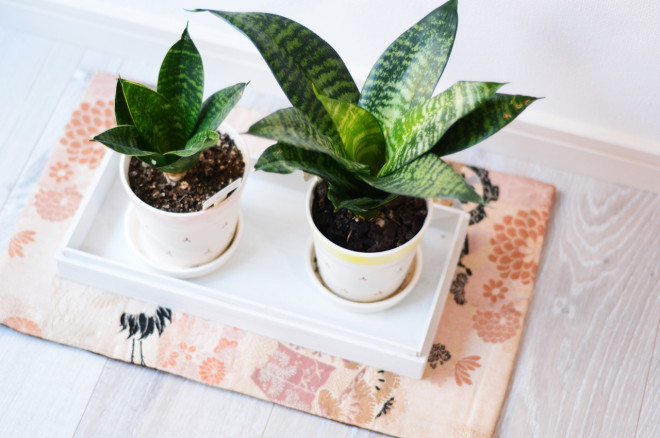Discovering new ways to live greener include literally greening our living spaces. Houseplants are a great way to bring some of the physical and emotional benefits of nature into the home or office.
Research conducted by NASA and the Associated Landscape Contractors of America found that several types of plants help filter common household toxins like volatile organic compounds (VOCs). Not surprisingly, a lot of household products and building materials contain VOCs, and with the extra time spent indoors, with closed windows and re-circulating air, houseplants are a great option to help reduce the impact of VOCs.
According to the NASA Clean Air Study, both the chrysanthemum (Chrysanthemum morifolium) and the peace lily (Spathiphyllum ‘Mauna Loa’) are plant powerhouses for removing common indoor air pollutants such as benzene, formaldehyde, trichloroethylene, xylene and toluene, as well as ammonia. The study suggested that ideal air purification is achieved with a minimum of one plant per 100 square feet of home or office space.
5 Houseplants That Clean Indoor Air
This is a short list of other common houseplants used to clear out air pollutants in your home, which can be ethically sourced and affordable :
- Spider plant (Chlorophytum comosum). Not only is this a hardy plant even for the greenest green thumb, but it is a great pet-friendly choice as well. It helps neutralize benzene, formaldehyde, carbon monoxide, and xylene, which is typically used as a solvent in the leather, rubber and printing industries.
- Aloe (Aloe vera). This is another easy-to-grow option that thrives with lots of sunlight and is helpful for removing the byproducts of chemical-based cleaners and paints such as formaldehyde and benzene.
- Weeping fig (Ficus benjamina). The ficus is for the intermediate green thumb, as it can be finicky until you get the right levels of watering and light, but they are wonderful for filtering out carpet and furniture pollutants like formaldehyde, benzene and trichloroethylene.
- Azalea (Rhododendron simsii). If you have a bright spot in your basement, you may want to consider introducing an azalea shrub. It prefers cooler temperatures and can help zap formaldehyde from plywood or foam insulation.
- Chinese evergreen (Aglaonema Crispum ‘Deborah’). This is another no-fuss plant that will bloom and produce red berries even in low light. Its ability to remove toxins actually increases over time and with continued exposure.
In addition to their detoxifying properties, plants consume carbon dioxide and release oxygen. The former is associated with increased drowsiness and the latter can actually improve your night’s sleep. Some articles suggest placing a plant like gerbera daisies, which release oxygen at night, beside your bed to help improve oxygen levels while you sleep. Plants are also excellent natural humidifiers and can improve household moisture levels, particularly in dry climates.
Looking for Low Maintenance Houseplants that also Purify Air?
Yes, they exist:, if you’re looking for a foolproof way to incorporate plants in your home but don’t have a lot of time to spend watering and looking after them, you may want to consider a product like the Pikaplant.
This shelving unit is advertised as a “low-maintenance vertical garden.” It works by mimicking the natural wet-dry cycle of ground water with an integrated water reservoir. Each shelf is covered in a capillary fabric, which draws water from the reservoir and transfers it to the plants. Once the fabric becomes dry for a day, the shelf is refilled by the reservoir, thus making it virtually impossible to kill your plants—provided you keep the reservoir full.
The Dutch company explains its mission to bring plant power to the people: “A plant rich environment makes people more creative, more productive, and generally happier too.” Currently the Pikaplant is only available in stores in Europe, the UK and Hong Kong, but they will ship internationally. You may be just a Pikaplant away from harnessing the benefits of household plants and improving indoor air quality naturally!
The winter is long and we spend so much of our time indoors. Injecting some greenery will go a long way to improving your wellbeing in more ways than one!
About The Author

-
Serial Entrepreneur, Technologist and Inventor.
My objective is to develop useful products that have a net positive effect in the lives of those that use them and the environment that we live in.
CEO of Mission LED Lighting Company Ltd.
- 2017.05.24LED factsWhy Are Cars Switching to LEDs if They’re Too Bright?
- 2017.05.09Be green & saveHow to Easily Replace T8 Fluorescent Tubes With LED
- 2017.03.07Build a better future7 Things About Explosion Proof LED Lighting You Should Know
- 2017.02.28Be green & saveWhy We Love LED Grow Lights (And You Should, Too!)





Live.com
Helpful information. Fortunate me I found your web site by accident, and
ReplyI’m surprised why this twist of fate didn’t happened earlier!
I bookmarked it.
John Keirstead
Thank you for bookmarking! We’re just trying to help build a better world and it’s very rewarding to read people like our articles. Enjoy your day!
Reply